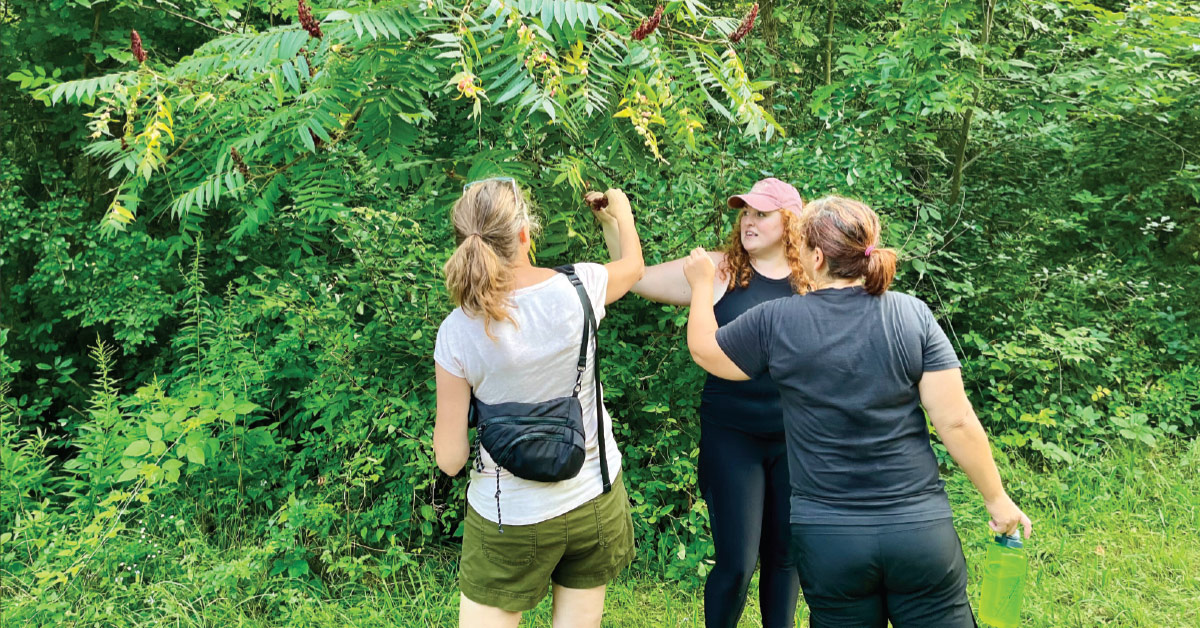Your Monthly Guide to What’s Great in the Great Outdoors
I was on a hike with friends a couple weeks ago and we encountered some very large, Alice-in-Wonderland-esque mushrooms. One of the group wondered aloud if they were edible, despite their very “don’t eat me” vibe. (Don’t worry, we didn’t.) On a related note, which I’ll get to momentarily, a friend of mine has gotten into poison ivy not once, but twice in the past three weeks and is not having a fun time of it. This got me thinking…
Maybe those of us who spend time outside, whether in the woods or working in our gardens, should amass a little knowledge of what’s out there: the good, the bad, and the itchy. So, I contacted Heather, who runs Rooted Connections, to see if she could give some of us a primer. Heather has been passionate about foraging and native plants for several years, but really dug into it after studying some of the most credible books on the subject, taking classes and certification courses, and doing her own knowledge-driven experimenting in her home kitchen. Opening her business and conducting guided walks was the next logical step, and that takes us to the present.
We met at Donald Lamoreaux Trail, one of a few of Heather’s preferred spots that has lots to discover. She started out by expressing strong caution with foraging, noting that there are many lookalikes out there, and plucking the wrong choice or trusting unreliable identifier apps could have toxic effects. She also urged us to have respect for the natural world, and to not view everything in front of us to be ours for the taking. While invasive species might have a target on them, native species should be treated with care and discretion when harvesting.
As part of her pre-walk presentation, Heather shared some of her favorite authors and their publications, which include Sam Thayer’s Field Guide to Edible Wild Plants and The Forager’s Harvest, as well as the Peterson Field Guide to Medicinal Plants & Herbs, by Steven Foster and James A. Duke. Those are just the beginning, and her large library is a testament to her commitment to deep plant understanding.
After we signed our waivers, we set off, but we were only a few steps in when we happened on our first couple of specimens: “weeds” we commonly see in our yards that can be used in salads or as seasonings. As we continued, she talked about goldenrod and the bad rap it’s gotten, even though it’s really ragweed, which puts out pollen at the same time goldenrod is flowering, that’s the real cause of our nasal distress.
Further in, we got to distinguish the difference between poison ivy and Virginia creeper, which often intertwine with one another and create confusion—even though they don’t have much resemblance. I’ll admit that even though I’ve heard the “leaves of three, let it be” mantra for years, I don’t know that I’ve actually recognized poison ivy when I’ve seen it. It seems a bit reckless of me not to be on higher alert, considering how much time I spend trekking through forests. Ah, well. I know now!
I’m not going to give away all of Heather’s expertise, though. You should really just go on one of her plant walks yourself, while the weather is still amenable. But, I will say that one of the more exciting species we came upon is Staghorn sumac, which probably every one of us has seen growing along the highway, on a trail, or even in our backyards.
I learned about it in a nature class as a kid and will often take a nibble of these trees’ fuzzy red berries when I come across one. They have a nice lemon flavor and, when ground, are used extensively in Mediterranean cuisine. They also brew into a delicious “pink lemonade” tea, which Heather made ahead of time and shared with us. Super refreshing! Now, you might be thinking about poison sumac and wondering why we would risk it. But, the two trees look virtually nothing alike, from the leaves to the berries. So, this is one of those rare safe bets.
There’s more, of course. A lot more. If you’re interested in foraging, or just don’t want to get in a tangle with the wrong plant, a walk with Rooted Connections should be on your to-do list. Head to linktr.ee/rootedconnections.mi to get pointed to her Facebook and Instagram pages, and also to see upcoming classes and purchase tickets





